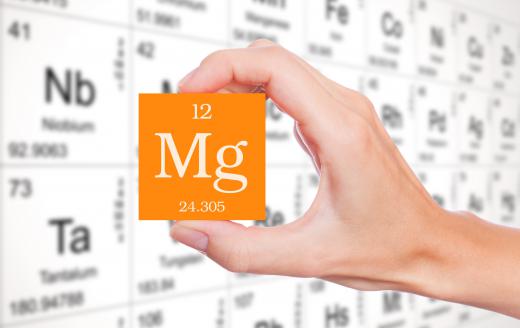What are the Properties of Magnesium?
Magnesium is a chemical element that is required by all living cells of all known organisms. When the elements in the earth’s crust are measured by mass, magnesium is the eighth most common. In seawater, it is the third most common. The properties of magnesium lead to its uses in truck and automotive components, such as mag wheels. The name for magnesium comes from the ancient Greek district of Magnesia.
The symbol for magnesium is Mg, and this element, uncombined, is not found on Earth naturally. It forms a metal and is part of a group known as the alkaline earth metals, elements of the periodic table that comprise Group 2. The properties of magnesium metal are that it is very reactive and highly flammable when in the form of thin strips or a powder, but not in bulk.

Magnesium fires are difficult to extinguish once ignited, since they can burn in both nitrogen and carbon dioxide. Water cannot be used, since magnesium reacts with it to form hydrogen gas, which is highly flammable. The only way to extinguish this type of fire is to smother it under sand or use a dry chemical fire extinguisher. This property of magnesium led to its use in the firebombing of cities in World War II.

The powder formed by magnesium is used in marine flares and to manufacture pyrotechnics. It was used to create a brilliant white light in the early days of photography. The temperature of magnesium flames can reach 2500°F (1,371°C). There are a number of other practical uses for this metal, including combination in alloys with zinc, aluminum, or manganese for making aerospace components, racing bikes, and missiles.

Humans require magnesium for over 300 biochemical reactions, including those that make DNA and RNA. Deficiency in the human diet is relatively common, possibly leading to diseases such as osteoporosis and asthma. About half of the body’s magnesium is found in the bone. Green leafy vegetables are a good dietary source of magnesium. Other sources include cereals, coffee, cocoa, tea, nuts, and spices.

Magnesium has an atomic mass of 24.3 and is number 12 in the period table. The physical properties of magnesium include a melting point of 1202°F (650°C) and a boiling point of 1994°F (1091°C). This high melting point leads to magnesium remaining solid in fires. Its crystals are hexagonal. The density is 1.74 g/cm3, which is low compared to other metals, such as aluminum.

The chemical properties of magnesium include having a tendency to react with halogens, such as chlorine, to form ionic salts. Magnesium has two electrons in its outermost shell, giving it an oxidation state of +2. The loss of these two electrons to form a stable ionic compound is energetically favorable, so magnesium is generally found as a salt. Such a reaction is that of magnesium with chlorine in seawater to form MgCl2.

The salts of magnesium have many uses, particularly magnesium sulfate, MgSO4. The properties of magnesium sulfate include a tendency to absorb water from the air. This makes it useful as a drying agent. Such magnesium sulfate is known as anhydrous, or lacking water.
The magnesium sulfate found naturally in mineral deposits and used medically is in a hydrated form, meaning it is associated with water molecules. For instance, Epsom salt is MgSO4.7H2O. A significant medical use has been to reduce eclampsia in pregnant women. In rare cases, an excessive consumption of magnesium from laxatives and antacids can be toxic.
Plants require magnesium, because it is at the center of the chlorophyll molecules used in photosynthesis. To ensure the plants have enough of this element, magnesium sulfate is frequently used as a plant fertilizer. The high solubility of magnesium sulfate gives it an advantage over other types of magnesium fertilizers.
AS FEATURED ON:
AS FEATURED ON:
















Discuss this Article
Post your comments